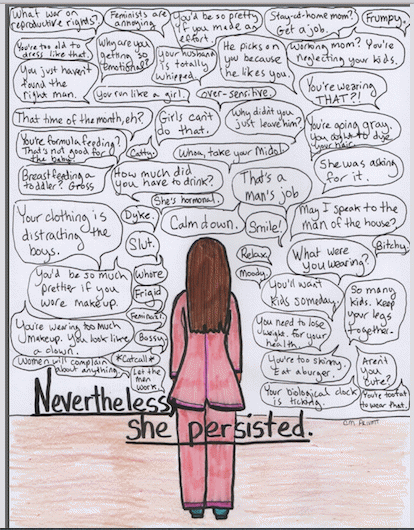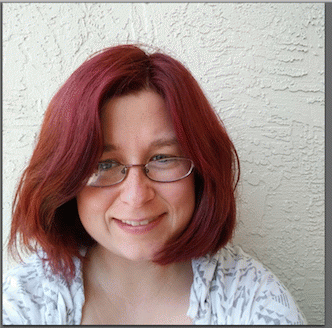My guest today is Courtney Privett, writer, artist, engineer, analytical chemist, mother.
Joan Brunwasser: Welcome to OpEdNews, Courtney. You've written ten novels already but something happened this month that shone the spotlight on you in a way your writing has not - at least, not yet. Can you tell our readers about how this came about?
Courtney Privett: I often use art as a means of relieving my anxieties and fears. I've been on a political art kick lately because I found myself unable to focus enough to write but I still had a lot of churning creative energy and anxiety to burn.
The day after Elizabeth Warren was silenced by Mitch McConnell, I was reading the news while feeding my daughters breakfast. Three male Senators had already been allowed to read Coretta Scott King's letter and I believe a fourth was about to. Then I read McConnell's quote. "She was warned. She was given an explanation. Nevertheless, she persisted." I had a little epiphany there and remembered all the times I was silenced or ignored and all the times I was insulted, by both males and females. I didn't want my daughters to grow up hearing the same things I had.

Nevertheless She Persisted: the artwork that caught fire
(Image by courtesy of Courtney Privett) Details DMCA
I decided to flip McConnell's quote into a positive as a way of saying, "Yeah, well, you threw all of this at me and I never gave up." The speech bubbles came at me in a whirlwind as I began writing them. Many had been directed toward me through my life, and others toward my friends. The frequent paired opposites made me realize that no matter what we did, there was someone who would criticize us for it. One at a time, these words don't feel like much, but together and over time they become a swarm. I chose to face the woman in the image away from the viewer both to make her anonymous (and therefore she could be any and all of us) and so she was facing all of these insults and microaggressions head-on and not backing down. They may have made her pause with self-doubt, but she still kept pushing forward.
I post most of my artwork on my Facebook page, so this one went into the folder with the others. Within a few minutes, two of my friends asked if they could share it. Twenty-four hours later, it was everywhere.
JB: Why do you think this particular piece so resonated with individuals that it went viral almost instantly?
CP: The most common comment I've received is along the lines of "I relate to this. I've heard so many of these things." That revealed just how widespread this issue is in our society. We hear these words from childhood onward and they are so ingrained in our society that we often don't notice them. They may bother us on an individual level, but I think people didn't realize that everyone else is hearing them, too. We went from feeling alone to knowing that we're all together in this, and by recognizing that, maybe we can collectively do something about it. I was surprised just how many people my piece resonated with. I've gotten comments and stories from people from a variety of backgrounds -- different political affiliations, religions, sexualities, races, and genders -- and so many of them said, "I've heard many of these things. I've even said many of these things to others. It's empowering to know I'm not alone in persisting through it and it has made me think more about how I speak to others."
JB: Do you think the energy to push back reflected in your piece was affected by the Women's March on Washington and the many satellite marches that took place the day after the inauguration and just a few weeks before your artwork appeared on Facebook?
CP: The Women's March certainly amplified the message (I wasn't able to go to my local one because I had bronchitis), but I've been pushing back a lot longer than that. I had to. I was often the only female in my classes and activities and had to stand up for myself and keep going when people (often adults), said things to me that implied I had no business doing things like pursuing engineering or playing hockey. So many of us have been pushing back for most of our lives, and we were going at it alone until recently. Now we're doing it together, and that strengthens both our voices and our resolve.
JB: I understand that you also generated a male-based version of your now viral artwork. How did that come about?
(Note: You can view every article as one long page if you sign up as an Advocate Member, or higher).






